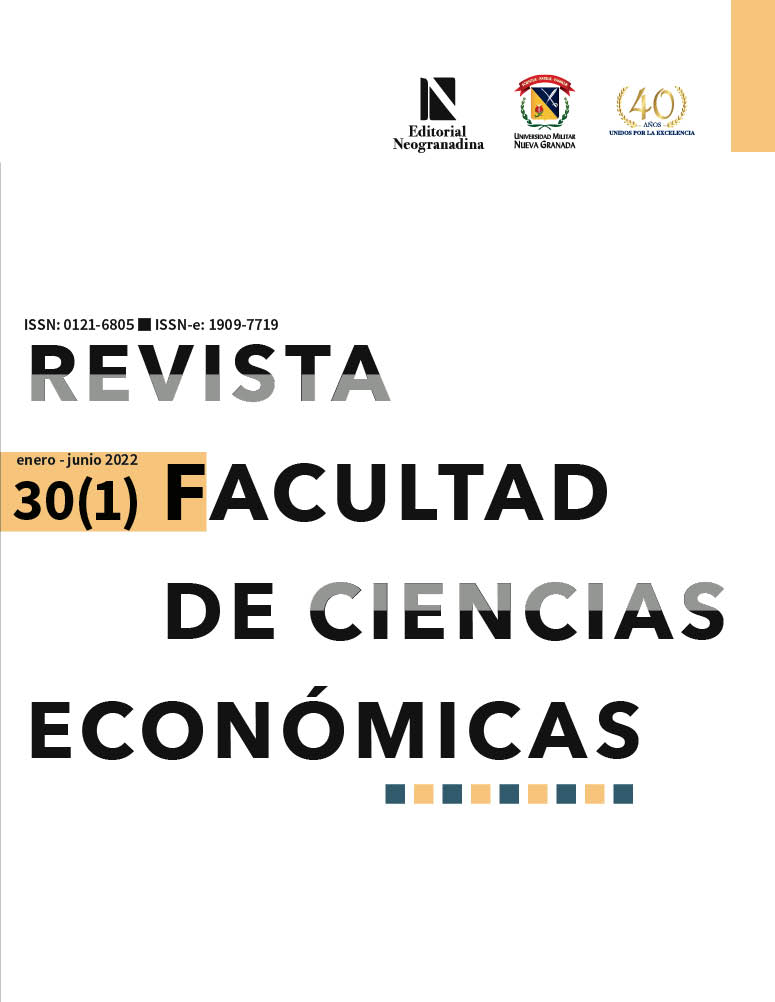Immigration and the Venezuelan crisis
the short-term effect on socioeconomic indicators of Norte de Santander
Abstract
This research identifies the effects of the Venezuelan migratory phenomenon on a key group of indicators that approximates different economic and social dimensions of the department of Norte de Santander in the period 2012-2019, through a descriptive analysis and the estimation of a linear regression model. It was found that almost all of the employment indicators examined show a marked deterioration in Norte de Santander at a time when the migratory flow from Venezuela is growing, and an increase in the demand for public services stands out. A statistically significant negative net effect of migration on economic growth was estimated. The estimate of the impact of the Venezuelan economic crisis, examined through the foreign trade channel, was not conclusive. The department managed to soften the impacts by diversifying its trading partners and transforming its export basket.
Downloads
References
Alcaldía de San José de Cúcuta. (2018, diciembre 26). Presupuesto general de rentas, recursos de capital y gastos del municipio de San José de Cúcuta, para la vigencia fiscal del 12 de enero al 31 de diciembre del año 2019. https://cucutanortedesantander.micolombiadigital.gov.co/sites/cucutanortedesantander/content/files/000440/21957_presupuesto-municipal--vigencia-2019.pdf
Aleksynska, M. y Tritah, A. (2015). The Heterogeneity of Immigrants, Host Countries' Income and Productivity: A Channel Accounting Approach. Economic Inquiry, 53(1), 150-172. DOI: https://doi.org/10.1111/ecin.12141
Alesina, A., Harnoss, J. y Rapoport, H. (2016). Birthplace Diversity and Economic Prosperity. Journal of Economic Growth, 21(2), 101-138. https://doi.org/10.1007/s10887-016-9127-6 DOI: https://doi.org/10.1007/s10887-016-9127-6
Banco Mundial. (2018). Migración desde Venezuela a Colombia: impactos y estrategia de respuesta en el corto y mediano plazo. http://healthandmigration.paho.org/xmlui/handle/123456789/492
Bellini, E., Ottaviano, G., Pinelli, D. y Prarolo, G. (2008). Cultural Diversity And Economic Performance: Evidence from European Regions (HWWI Research Paper N.o 3-14). Hamburg Institute of International Economics (HWWI). https://econpapers.repec.org/paper/zbwhwwirp/3-14.htm
Böhme, M. H. y Kups, S. (2017). The Economic Effects of Labour Immigration In Developing Countries: A literature Review. En OECD Development Centre Working Papers (N.o 335). OECD Publishing. https://ideas.repec.org/p/oec/devaaa/335-en.html
Borjas, G. J. (2003). The Labor Demand Curve is Downward Sloping: Reexamining the Impact of Immigration on the Labor Market. The Quarterly Journal of Economics, 118(4), 1335-1374. DOI: https://doi.org/10.1162/003355303322552810
Boubtane, E., Dumont, J.-C. y Rault, C. (2016). Immigration and Economic Growth In The OECD Countries 1986-2006. Oxford Economic Papers, 68(2), 340-360. DOI: https://doi.org/10.1093/oep/gpw001
Campo, F., Forte, G. y Portes, J. (2018). The Impact of Migration on Productivity and Native-Born Workers' Training. 2018, (IZA Discussion Paper No. 11833), 48. DOI: https://doi.org/10.2139/ssrn.3261692
Card, D. (2001). Immigrant Inflows, Native Outflows, and the Local Labor Market Impacts of Higher Immigration | Journal of Labor Economics: 19(1), 22-64. DOI: https://doi.org/10.1086/209979
Card, D. (2005). Is the New Immigration Really so Bad? | The Economic Journal | Oxford Academic. The Economic Journal, 115, F300-F323. DOI: https://doi.org/10.1111/j.1468-0297.2005.01037.x
d'Albis, H., Boubtane, E. y Coulibaly, D. (2016). Immigration Policy and Macroeconomic Performance in France. Annals of Economics and Statistics, (121/122), 279-308. JSTOR. DOI: https://doi.org/10.15609/annaeconstat2009.121-122.279
Departamento Administrativo Nacional de Estadística [DANE]. (2019). Estadísticas por tema. Colombia. https://www.dane.gov.co/
Departamento Nacional de Planeación [DNP]. (2018). Terridata. Fichas territoriales departamentales y municipales. https://terridata.dnp.gov.co/index-app.html#/perfiles
Dolado, J. J., Goria, A. e Ichino, A. (1994). Immigration, Human Capital and Growth in the Host Country: Evidence from Pooled Country Data. Journal of Population Economics, 7(2), 193-215. DOI: https://doi.org/10.1007/BF00173619
Dustmann, C. (1994). Speaking Fluency, Writing Fluency and Earnings of Migrants. Journal of Population Economics, 7(2), 133-156. DOI: https://doi.org/10.1007/BF00173616
Edwards, S. (1989). Real Exchange Rates in the Developing Countries: Concepts and Measurement (Working Paper N.o 2950). National Bureau of Economic Research. DOI: https://doi.org/10.3386/w2950
Fedesarrollo. (2018a). Informe mensual de mercado laboral. Migración venezolana a Colombia. https://www.repository.fedesarrollo.org.co/bitstream/handle/11445/3688/IML_Octubre_2018.pdf?isAllowed=y&sequence=1
Fedesarrollo. (2018b, octubre). Elementos para una política pública frente a la crisis de Venezuela. https://www.fedesarrollo.org.co/sites/default/files/elementosvenezuela.pdf
Felbermayr, G., Hiller, S. y Sala, D. (2010). Does immigration boost per capita income? Economics Letters, 107(2), 177-179. DOI: https://doi.org/10.1016/j.econlet.2010.01.017
Friedberg, R. M., y Hunt, J. (1995). The Impact of Immigrants on Host Country Wages, Employment and Growth. Journal of Economic Perspectives, 9(2), 23-44. DOI: https://doi.org/10.1257/jep.9.2.23
Galvis, D. L., Sarmiento, J. A. y Silva, A. (2020). Perfil laboral de los migrantes venezolanos en Colombia - 2019. Encuentros, 18(02), 121-122.
Kerr, S. y Kerr, W. (2011). Economic Impacts of Immigration: A Survey (NBER Working Paper N.o 16736). National Bureau of Economic Research, Inc. https://econpapers.repec.org/paper/nbrnberwo/16736.htm DOI: https://doi.org/10.3386/w16736
Migración Colombia. (2019). Total de venezolanos en Colombia. Corte a 31 de diciembre de 2019. https://www.migracioncolombia.gov.co/infografias/total-de-venezolanos-en-colombia-corte-a-31-de-diciembre-de-2019
Ministerio de Educación Nacional [MEN]. (2019). Estadísticas e indicadores. Colombia. https://www.mineducacion.gov.co/1621/article-123926.html#:~:text=Se%20define%20como%20el%20porcentaje%20de%20la%20poblaci%C3%B3n%20entre%20quince,edad%20para%20obtener%20resultados%20focalizados.
Ministerio de Salud. (2019). Cifras de aseguramiento en salud. [Tablero interactivo]. https://www.minsalud.gov.co/proteccionsocial/Paginas/cifras-aseguramiento-salud.aspx
Ministerio de Salud. (2018). Informe de Gestión 2018. La salud es de todos (p. 109). https://www.minsalud.gov.co/sites/rid/Lists/BibliotecaDigital/RIDE/DE/PES/rendicion-cuentas-informe-gestion-2018.pdf
Muysken, J. y Ziesemer, T. (2011). The Effect of Net Immigration on Economic Growth in an Ageing Economy: Transitory and Permanent Shocks. DOI: https://doi.org/10.2139/ssrn.1949677
Orefice, G. (2010). Skilled migration and economic performances: Evidence from OECD countries. Swiss Journal of Economics and Statistics, 146(4), 781-820. DOI: https://doi.org/10.1007/BF03399337
Organización para la Cooperación y el Desarrollo Económico (OECD) y Organización Internacional del Trabajo. (2018). How Immigrants Contribute to Developing Countries' Economies.
Ortega, F. y Peri, G. (2009). The Causes and Effects of International Migrations: Evidence from OECD Countries 1980-2005 (Working Paper N.o 14833). National Bureau of Economic Research. DOI: https://doi.org/10.3386/w14833
Ortega, F. y Peri, G. (2014). The Aggregate Effects of Trade and Migration: Evidence from OECD Countries. En A. Artal-Tur, G. Peri y F. Requena-Silvente (Eds.), The Socio-Economic Impact of Migration Flows: Effects on Trade, Remittances, Output, and the Labour Market (pp. 19-51). Cham: Springer International Publishing. DOI: https://doi.org/10.1007/978-3-319-04078-3_2
Ottaviano, G. I. P. y Peri, G. (2008). Immigration and National Wages: Clarifying the Theory and the Empirics (Working Paper N.o 14188). National Bureau of Economic Research. DOI: https://doi.org/10.3386/w14188
Reina, M., Mesa, C. A. y Ramírez, T. (2018). Elementos para una política pública frente a la crisis de Venezuela. http://www.repository.fedesarrollo.org.co/handle/11445/3716
Revista Semana. (2019, agosto 17). La migración venezolana golpea la salud colombiana. https://www.semana.com/nacion/articulo/consecuencias-en-salud-de-la-migracion-venezolana-en-colombia/628373/
Sierra, L. P., Collazos, J. A., Sanabria, J. y Vidal, P. (2017). La construcción de indicadores de la actividad económica: una revisión bibliográfica. Apuntes del Cenes, 36(64), 79-107. DOI: https://doi.org/10.19053/01203053.v36.n64.2017.5132
Sistema Único de Información de Servicios Públicos Domiciliarios [SUI]. (2019). Indicadores y reportes de Información de los servicios públicos domiciliarios del país. Colombia. http://www.sui.gov.co/web/
Smith, C. y Thoenissen, C. (2018). Migration and business cycle dynamics. En CAMA Working Papers (N.o 2018-20). Centre for Applied Macroeconomic Analysis, Crawford School of Public Policy, The Australian National University. https://ideas.repec.org/p/een/camaaa/2018-20.html DOI: https://doi.org/10.2139/ssrn.3171890
Vidal, P., Sierra, L. P., Sanabria, J. y Collazos, J. A. (2015). Indicador Mensual de Actividad Económica (IMAE) para el Valle del Cauca. Borradores de Economía. https://www.banrep.gov.co/sites/default/files/publicaciones/archivos/be_900.pdf
Vidal, P., Sierra, L. P., Sanabria, J. y Collazos, J. A. (2017). A Monthly Regional Indicator of Economic Activity: An Application for Latin America. Latin American Research Review, 52(4), 589-605. (27 monthly variables related to the economic activity). DOI: https://doi.org/10.25222/larr.38
Vidal, P., Ramírez, G. y Sierra, L. P. (2021). Un análisis regional de los choques monetarios y externos: el caso del Valle del Cauca en Colombia. Cuadernos de Economía, 40(82), 57-81. DOI: https://doi.org/10.15446/cuadecon.v40n82.78759
Copyright (c) 2022 Revista Facultad de Ciencias Económicas

This work is licensed under a Creative Commons Attribution-NonCommercial-NoDerivatives 4.0 International License.











